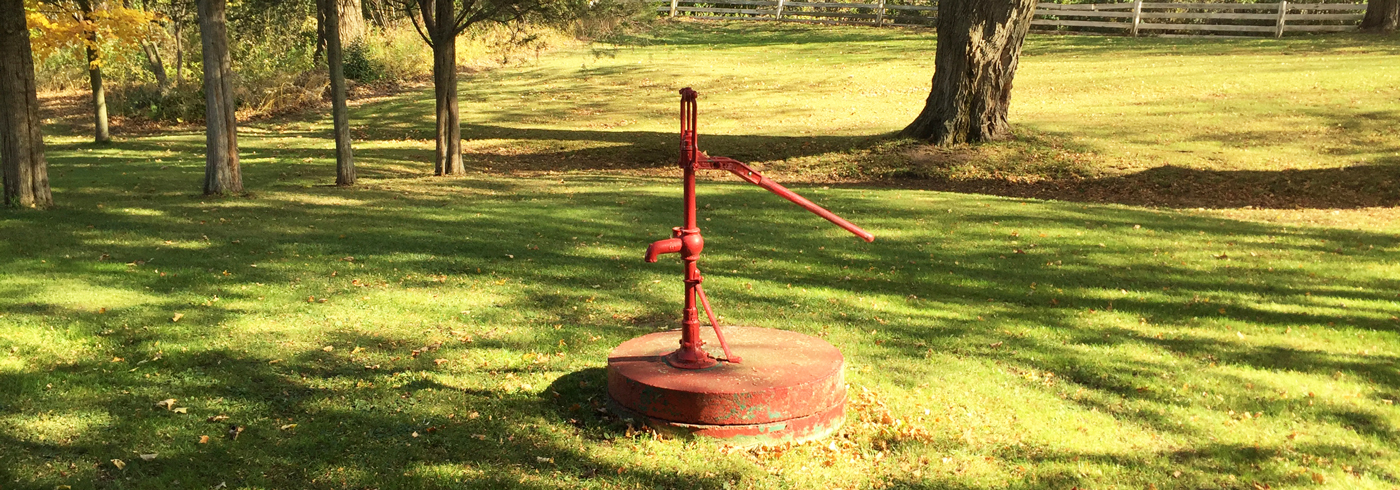
Private Wells
Free water testing services
Free water testing services are available for all Durham Region residents who want to check the quality of their own private well water supply. Residents can pick-up and drop-off water samples at any of our service locations.
Notice of service disruption
There will be a scheduled service disruption at the Health Department office located at 101 Consumers Drive, Whitby. Due to ongoing renovations, all Health Department services, including water sample pick up and drop off, will not be available at this location until further notice.
- Where: 101 Consumers Drive, Whitby
- When: July 26, 2024 at 10 a.m. until further notice
Read our notice of service disruption for further information.
Welcome to your well
The Private Well Water Manual was designed to help you keep your well water supply safe and to serve as a reference guide for well owners. This manual has information on various topics including:
- Basic principles of ground water.
- Types of wells and how they are made.
- Tips for finding and fixing well water problems.
- How to sample your water.
- How to treat your water.
Private Well Water Manual (a quick user guide)
| Water sample bottle pick-up and drop-off locations for bacteriological water testing | ||
|
Durham Region Health Department offices and the provincial laboratory where water samples are tested are both closed on observed statutory holidays.
Water sample bottle pick-up/drop-off locations and hours: The Regional Municipality of Durham Headquarters - 605 Rossland Rd. E., Whitby
Durham Region Health Department - 101 Consumers Dr., Whitby (East entrance)
Durham Region Health Department - North Office, 181 Perry St., Port Perry (East entrance)
Municipality of Clarington, Garnet B. Rickard Recreation Complex, 2440 Durham Regional Hwy 2, Bowmanville (Main entrance)
Township of Uxbridge Municipal Office, 51 Toronto St., Uxbridge (Main entrance)
Township of Brock Municipal Office, 1 Cameron St. E., Cannington (Main entrance) Monday to Friday from 8:30 a.m. to 4:30 p.m. (Pick-up location only) Public health inspectors are available by phone should you have questions about water sampling, wells or water sample interpretation. For questions please contact the Durham Health Connection line at 905-668-2020 (choose option "3"). |
||
| Well water sampling | ||
Taking a water sampleTest your drinking water for the presence of harmful bacteria at least three times a year. View our nine step water sampling resourceStep 1Use a water sample bottle with attached form. You can get these from the Health Department or Ontario Ministry of Health and Long-Term Care Public Health Laboratory. Step 2Remove all attachments from the faucet including the aerator, rubber washer and any hoses. Step 3Be sure to disinfect the tap with alcohol or plain bleach (5.25 per cent sodium hypochlorite). Step 4Run cold water tap for a minimum of five minutes. Step 5Unscrew cap from water sample bottle. Be sure not to contaminate the inside of the cap or the neck of the sample bottle with your fingers. Step 6Fill bottle to 200 mL water line indicated on bottle. Step 7Screw cap on tightly. Step 8Fill out the form that is comes with the water sample bottle. Remember to write the PIN on the form so you can get your results over the phone. Step 9Put bottle filled with water sample inside an insulated cooler with ice pack and take everything to the nearest drop-off location. Note: All laboratories must receive water samples within 24 hours of the sampling date. Samples received after 24 hours will not be tested. |
||
| Well water contamination | ||
|
What should I do if I suspect my well water is not safe?
If only bacteriological contamination is present and you want to continue using the water from your well, bring water to a rapid rolling boil for at least one minute and let it cool before using it for drinking, making infant formula, juices, ice or recipes, brushing your teeth, rinsing contact lenses, and washing food or dishes. Refrigerate your boiled water until it is finished. Also see Facts About ... Boil water advisories for additional information. Note: If chemical contamination (e.g. pesticides, oil, gasoline, etc.) of your well water supply is suspected, do not boil your drinking water. Contact the Durham Health Connection Line for further advice. |
||
| Disinfecting your well | ||
Protect your skin from splashes from the bleach by using gloves, goggles and clothing. Never mix bleach with other chemicals.
Be sure you have another safe, potable source of water to use during this process. |
||
| Well maintenance and inspection | ||
|
Wells require maintenance as they age. Use the Homeowners well maintenance and inspection checklist to regularly inspect your well. Warning: Do not enter a well or well pit at any time during an inspection. When a well is no longer in use contact the Ministry of the Environment Conservation and Parks (MECP) for advice on abandoning the well. |
||
| Well records | ||
| Well contractors must provide you with a copy of your well record when a well is constructed or altered. If you do not have a copy of your well record, you may obtain a copy by visiting the Ministry of the Environment, Conservation and Parks (MECP) website. | ||
| Well abandonment | ||
|
You should think about properly abandoning or plugging your well if:
An Ontario Ministry of the Environment Conservation and Parks (MECP) licensed well contractor must be hired to abandon the well. *Source: Best Management Practices: Water Wells (Ontario Ministry of Agriculture, Food and Rural Affairs/Agriculture and Agri-Food Canada) |
||
| Additional resources | ||
Contact Us




